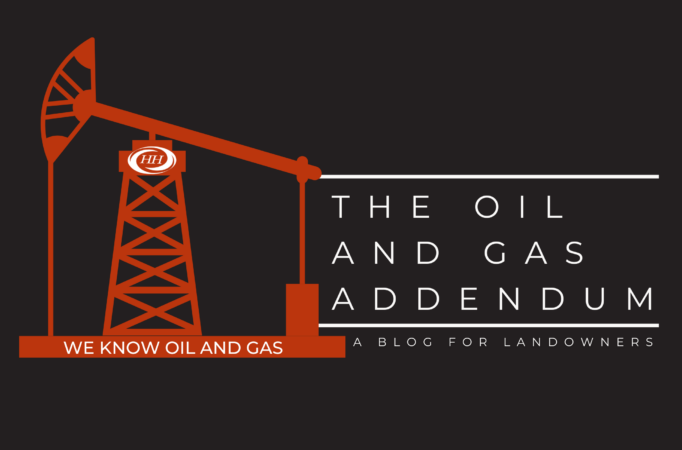The Oil and Gas Addendum
Ohio Court Rules That Driller Did Not Breach Lease By Deducting Post-Production Costs Incurred By Affiliate
Assume you own 110 acres of timber in Washington County. You decide to cut and clear 75 acres. You hire ABC Logging Inc. (“ABC Logging”) to cut and sell the timber. ABC Logging agrees to pay you a royalty of 25% of the proceeds received from the sale of your timber. As per your logging contract, ABC Logging will sell the felled timber to third-parties. One of those third-parties is Big Furniture LLC (“BFL”), who has agreed to take delivery of the felled timber at the edge of your driveway. It is your understanding that title to the timber will transfer at that location and that your royalty will be based on the sale proceeds ABC Logging receives from BFL at that same location.
Imagine, however, if ABC Logging tried to deduct from your royalty the costs BFL incurs to transport and move the felled timber from your farm to BFL’s processing facility in Waynesburg, Greene County. The idea itself is preposterous and defies common sense. How can ABC Logging deduct costs that are incurred after it sells the timber to BFL? To most people, the notion that ABC Logging can deduct BFL’s costs from your royalty is illogical and simply absurd.
Yet, in the modern oil/gas world, this alarming practice is becoming more common. Gas drillers throughout the Marcellus region often try to deduct remote downstream costs from the landowner’s royalty. These drillers invoke the so-called “netback” method as justification for their practice of deducting costs incurred between the well-head and the downstream point-of-sale. The “net back” method, however, cannot supercede or override the express language set forth in the parties’ lease. Unfortunately, a recent decision issued by an appellate court in Ohio reflects the ongoing confusion regarding the correct application of the “netback” method. As detailed below, the court in Gateway Royalty LLC v. Chesapeake Exploration, et al (19 CA 0933, Seventh Appellate District, Carroll County Ohio, April 3, 2020), erroneously concluded that the parties’ lease and the “netback” method allowed the driller to deduct the downstream costs incurred by an affiliate.
At issue in Gateway were six oil/gas leases (the “Leases”). All six leases required that the landowner’s royalty of 12.5% be calculated on the price paid to the lessee for all hydrocarbons “marketed and used” off the premises:
“…as royalty for the gas marketed and used off the premises and produced from each well drilled thereon, the sum of one-eighth ( 1/8) of such gas so marketed and used at the price paid to Lessee….less any charges for transportation, compression and/or dehydration to deliver the gas for sale”
Chesapeake Exploration LLC ( “CEL”) drilled and operated several wells subject to the Leases. CEL then sold the gas to an affiliate, Chesapeake Energy Marketing LLC ( “CEM”), at or near the wellhead. This fact is significant: the gas did not need to be gathered, processed or transported prior to the first sale. CEM took possession of the gas at the well-head and then moved the gas downstream to a processing facility and thereafter sold the processed gas to third-parties. All of the gathering, processing and transportation costs were incurred by CEM and not CEL (the “CEM Post-Production Costs”).
The “price” CEM paid to CEL at the wellhead was based on the downstream price CEM received from the third-party buyers, less the CEM Post-Production Costs. It should be noted that all of the CEM Post-Production Costs were incurred downstream from the well-head and after CEM took possession of the gas. CEL then used that “netback” price to calculate Gateway’s production royalty. In other words, the royalty was not based on the actual downstream price but was instead based on a manufactured price artificially reduced by the downstream CEM Post-Production Costs.
In 2017, Gateway filed suit alleging that CEL breached the Leases by calculating the royalty on the wrong price. Gateway argued that the only true “price” paid for the gas was the price paid by the third-party buyers. As such, Gateway’s complaint alleged that the royalty should be based on that downstream price and not the artificial CEL-CEM well-head price. Gateway further argued that the royalty should be calculated without any assessment or deduction of post-production costs. In support for this proposition, Gateway noted that CEL did not incur or pay any post-production costs- all of the costs were actually incurred by CEM. Moreover, Gateway argued that all of the post-production activities, and hence the corresponding costs, occurred after CEL transferred title and ownership of the gas to CEM. Finally, Gateway contended that the Leases required the lessee, CEL, to calculate the royalty based on the “gas so marketed and used at the price paid to the lessee.” Since the CEL-CEM well-head transaction was not a true arms-length sale, Gateway argued that no “marketing” of the gas actually took place until it was sold downstream to the third-party buyers. Under Gateway’s theory, this meant the royalty had to be calculated and valued at the actual “marketing” location.
CEL defended the suit on the grounds that it was calculating the royalty in accordance with the Leases. CEL moved for summary judgment arguing that the Leases only require that the royalty be calculated on the “price paid” and that the Gateway royalty was, in fact, based on the price actually paid by CEM at or near the well-head. The trial court granted CEL’s motion and entered judgment in favor of CEL. Gateway then filed a timely appeal to the Seventh Appellate District in Carroll County.
On appeal, Gateway argued that summary judgment was premature because factual questions remained as to whether the CEL-CEM transaction constituted an actual sale in satisfaction of CEL’s duty to “market” the gas. Gateway contended that the trial court erred by ignoring evidence that called into question the mechanics of the purported CEL-CEM transaction. Gateway also argued that summary judgment was improper because none of the CEM Post-Production Costs were actually incurred by CEL- all of these costs were incurred by CEM after CEL transferred title to the gas at the well-head. The Seventh District rejected these arguments and opined that CEL correctly calculated the Gateway royalty by utilizing the “net back” price paid by CEM at the well-head.
The author submits that the Seventh District’s decision is flawed as it ignores the text of the underlying royalty clause and places undue reliance on the “netback” method. The “netback” method is only applicable when and if the royalty valuation point and the point-of-sale are different. In other words, if the parties’ lease says that the lessor is to be paid a royalty equal to “15% at the wellhead” but the gas is actually sold downstream, the “netback” method allows the driller to net out the intervening costs incurred between the valuation point ( i.e. the well-head) and the downstream point-of-sale. This accounting function allows the driller to arrive at a well-head value by subtracting out or deducting the intervening costs. Conversely, when the royalty valuation point is at the point-of-sale, there is no legal basis to apply the “netback” method. Nor does the “netback” method allow an affiliate to deduct costs and then pass those same costs onto the lessor. That is not the purpose of the “netback” method- the purpose is to arrive at a well-head value so a royalty can be calculated. In short, the “netback” method is not an automatic and universal rule that can be applied anytime a driller simply wants to deduct post-production costs. It is submitted that the Seventh District misunderstood how and when the “netback” method applies.
The Leases provided that Gateway was entitled to a royalty of 12.5% on “such gas so marketed and used at the price paid to Lessee….” The royalty clause further provided that CEL could deduct charges “for transportation, compression and/or dehydration to deliver the gas for sale.” The gas was sold to CEM at or near the well-head. No post-production activities were performed (and no such costs were incurred) prior to that sale. As such, there were simply no costs incurred by CEL to “deliver the gas for sale.” The analysis should have started and ended there. The “netback” method was simply inapplicable and should not have been relied upon- there was no need to net out costs between the location where CEM took possession of the gas and the eventual downstream sale location. The Seventh District erred by ignoring this language and engaging in an unwarranted and unnecessary application of the “netback” method.
About Us
Oil and gas development can present unique and complex issues that can be intimidating and challenging. At Houston Harbaugh, P.C., our oil and gas practice is dedicated to protecting the interests of landowners and royalty owners. From new lease negotiations to title disputes to royalty litigation, we can help. Whether you have two acres in Washington County or 5,000 acres in Lycoming County, our dedication and commitment remains the same.
We Represent Landowners in All Aspects of Oil and Gas Law
The oil and gas attorneys at Houston Harbaugh have broad experience in a wide array of oil and gas matters, and they have made it their mission to protect and preserve the landowner’s interests in matters that include:
- New lease negotiations
- Pipeline right-of-way negotiations
- Surface access agreements
- Royalty audits
- Tax and estate planning
- Lease expiration claims
- Curative title litigation
- Water contamination claims

Robert Burnett - Practice Chair
Robert’s practice is exclusively devoted to the representation of landowners and royalty owners in oil and gas matters. Robert is the Chair of the Houston Harbaugh’s Oil & Gas Practice Group and represents landowners and royalty owners in a wide array of oil and gas matters throughout the Commonwealth of Pennsylvania. Robert assists landowners and royalty owners in the negotiation of new oil and gas leases as well as modifications to existing leases. Robert also negotiates surface use agreements and pipeline right-of-way agreements on behalf of landowners. Robert also advises and counsels clients on complex lease development and expiration issues, including the impact and effect of delay rental and shut-in clauses, as well as the implied covenants to develop and market oil and gas. Robert also represents landowners and royalty owners in disputes arising out of the calculation of production royalties and the deduction of post-production costs. Robert also assists landowners with oil and gas title issues and develops strategies to resolve and cure such title deficiencies. Robert also advises clients on the interplay between oil and gas leases and solar leases and assists clients throughout Pennsylvania in negotiating solar leases.

Brendan A. O'Donnell
Brendan O’Donnell is a highly qualified and experienced attorney in the Oil and Gas Law practice. He also practices in our Environmental and Energy Practice. Brendan represents landowners and royalty owners in a wide variety of matters, including litigation and trial work, and in the preparation and negotiation of:
- Leases
- Pipeline right of way agreements
- Surface use agreements
- Oil, gas and mineral conveyances

